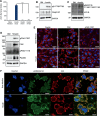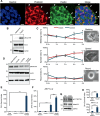Insulin Stimulates PI3K/AKT and Cell Adhesion to Promote the Survival of Individualized Human Embryonic Stem Cells
- PMID: 31021484
- PMCID: PMC6852186
- DOI: 10.1002/stem.3026
Insulin Stimulates PI3K/AKT and Cell Adhesion to Promote the Survival of Individualized Human Embryonic Stem Cells
Abstract
Insulin is present in most maintenance media for human embryonic stem cells (hESCs), but little is known about its essential role in the cell survival of individualized cells during passage. In this article, we show that insulin suppresses caspase cleavage and apoptosis after dissociation. Insulin activates insulin-like growth factor (IGF) receptor and PI3K/AKT cascade to promote cell survival and its function is independent of rho-associated protein kinase regulation. During niche reformation after passaging, insulin activates integrin that is essential for cell survival. IGF receptor colocalizes with focal adhesion complex and stimulates protein phosphorylation involved in focal adhesion formation. Insulin promotes cell spreading on matrigel-coated surfaces and suppresses myosin light chain phosphorylation. Further study showed that insulin is also required for the cell survival on E-cadherin coated surface and in suspension, indicating its essential role in cell-cell adhesion. This work highlights insulin's complex roles in signal transduction and niche re-establishment in hESCs. Stem Cells 2019;37:1030-1041.
Keywords: AKT; Caspase; Cell adhesion; Cell survival; Focal adhesion; IGF; Individualization; Insulin; Integrin; Niche; hESC.
© 2019 The Authors. Stem Cells published by Wiley Periodicals, Inc. on behalf of AlphaMed Press 2019.
Conflict of interest statement
The authors indicated no potential conflicts of interest.
Figures






References
Publication types
MeSH terms
Substances
LinkOut - more resources
Full Text Sources
Other Literature Sources
Medical

